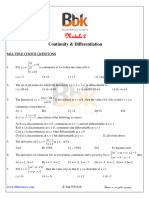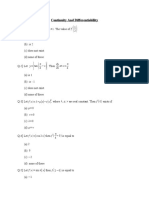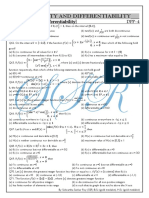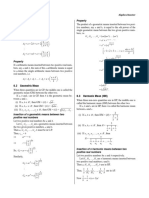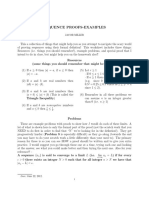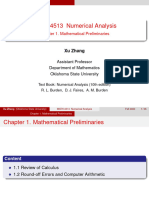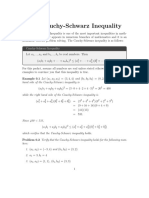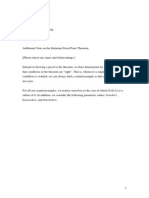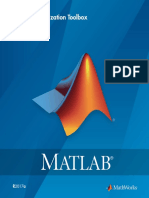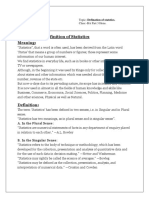Continuity and Differentiability - Worksheet
150. tan 𝑥−cot 𝑥 𝜋
𝜋 , 𝑥≠4
𝑥− 𝜋
Let 𝑓(𝑥) = { 4
𝜋
the value of 𝑎 so that 𝑓(𝑥) is continuous at 𝑥 = 4
is
𝑎, 𝑥=
4
a) 2 b) 4 c) 3 d) 1
𝑥
151. If 𝑓(𝑥) = ∫−1|𝑡| 𝑑𝑡, 𝑥 ≥ −1, then
a) 𝑓 and 𝑓′ are continuous for 𝑥 + 1 > 0
b) 𝑓 is continuous but 𝑓′ is not so for 𝑥 + 1 > 0
c) 𝑓 and 𝑓′ are continuous at 𝑥 = 0
d) 𝑓 is continuous at 𝑥 = 0 but 𝑓′ is not so
152. The set of points of discontinuity of the function
𝑥 −𝑛 −𝑥 𝑛
𝑓(𝑥) = lim ,𝑛 ∈ 𝑍 is
𝑛→∞ 𝑥 −𝑛 +𝑥 𝑛
a) {1} b) {−1} c) {−1, 1} d) None of these
153. The number of points of discontinuity of the function
1
𝑓(𝑥) = log |𝑥|, is
a) 4 b) 3 c) 2 d) 1
154. sin 3𝑥
, 𝑥≠0
𝑓(𝑥) = { sin 𝑥 is continuous, if 𝑘 is
𝑘, 𝑥=0
a) 3 b) 0 c) -3 d) -1
155. For the function 𝑓(𝑥) = log𝑒 (1+𝑥)+log𝑒(1−𝑥)
𝑥
to be continuous at = 0, the value of 𝑓(0) is
a) -1 b) 0 c) -2 d) 2
156. 𝑥−4
|𝑥−4|
+ 𝑎, 𝑥 < 4
Let 𝑓(𝑥) = 𝑎 + 𝑏, 𝑥 = 4
𝑥−4
{|𝑥−4| + 𝑏, 𝑥 > 4
Then, 𝑓(𝑥) is continuous at 𝑥 = 4, when
a) 𝑎 = 0, 𝑏 = 0 b) 𝑎 = 1, 𝑏 = 1 c) 𝑎 = −1, 𝑏 = 1 d) 𝑎 = 1, 𝑏 = −1
157. [𝑥]−1
,𝑥 ≠ 1
If 𝑓(𝑥) { 𝑥−1 then at 𝑥 = 1, 𝑓(𝑥) is
0, 𝑥=1
a) Continuous and differentiable
b) Differentiable but not continuous
c) Continuous but not differentiable
d) Neither continuous nor differentiable
158. 1−√2 sin 𝑥 𝜋
, if 𝑥≠ 𝜋
If 𝑓(𝑥) = { 𝜋−4𝑥 𝜋
4 is continuous at 4 , then 𝑎 is equal to
𝑎, if 𝑥 =
4
a) 4 b) 2 c) 1 d) 1/4
159. 𝑥 + 𝑎, if 𝑥 ≤ 1
If the function 𝑓: 𝑅 → 𝑅 given by 𝑓(𝑥) = { is continuous at 𝑥 = 1, thyen 𝑎 is
3 − 𝑥 2 , if 𝑥 > 1
equal to
a) 4 b) 3 c) 2 d) 1
160. If 𝑓: 𝑅 → 𝑅 is defined by
cos 3𝑥−cos 𝑥
, for 𝑥 ≠ 0
𝑓(𝑥) = { 𝑥2 and if 𝑓 is continuous at 𝑥 = 0, then 𝜆 is equal to
𝜆, for 𝑥 = 0
1
� Continuity and Differentiability - Worksheet
a) -2 b) -4 c) -6 d) -8
161. 𝑥 3 −𝑎3
,𝑥 ≠ 𝑎
For the function 𝑓(𝑥) = { 𝑥−𝑎 , if 𝑓(𝑥) is continuous at 𝑥 = 𝑎, then 𝑏 is equal to
𝑏, 𝑥=𝑎
a) 𝑎2 b) 2𝑎2 c) 3𝑎2 d) 4𝑎2
162. If 𝑦 = 𝑓(𝑥) = 1 where 𝑢 = 1 , then the function is discontinuous at 𝑥 =
𝑢2 +𝑢−1 𝑥−1
a) 1 b) 1/2 c) 2 d) −2
163. If 𝑓(𝑥) = Min {tan 𝑥 , cot 𝑥}, then
a) 𝑓(𝑥) is not differentiable at 𝑥 = 0, 𝜋/4, 5𝜋/4
b) 𝑓(𝑥) is continuous at 𝑥 = 0, 𝜋/2, 3𝜋/2
𝜋/2
c) ∫ 𝑓(𝑥)𝑑𝑥 = ln √2
0
𝜋
d) 𝑓(𝑥) is periodic with period 2
164. If 𝑓(𝑥) = {|𝑥| − |𝑥 − 1}2 , then 𝑓′(𝑥) equals
a) 0 for all 𝑥
b) 2{|𝑥| − |𝑥 − 1|}
0 for 𝑥 < 0 and for 𝑥 > 1
c) {
4(2 𝑥 − 1)for 0 < 𝑥 < 1
0 for 𝑥 < 0
d) {
4(2𝑥 − 1)for 𝑥 > 0
165. If 𝑓(𝑥) = (𝑥 − 𝑥0 )ϕ(𝑥) and ϕ(𝑥) is continuous at 𝑥 = 𝑥0 , then 𝑓′(𝑥0 ) is equal to
a) ϕ′(𝑥0 ) b) ϕ(𝑥0 ) c) 𝑥0 ϕ(𝑥0 ) d) None of these
166. The function defined by
1 −1
2
𝑓(𝑥) = {(𝑥 + 𝑒 2−𝑥 ) 𝑥 ≠ 2 is continuous from right at the point 𝑥 = 2, then 𝑘 is equal to
𝑘, 𝑥=2
a) 0 1 1 d) None of these
b) c) −
4 2
167. 1−sin 𝑥 log sin 𝑥 𝜋
2 ∙ 2 2) , 𝑥 ≠ 2
If 𝑓(𝑥) = {(𝜋−2𝑥) (log 1+𝜋 −4𝜋𝑥+𝑥 𝜋
is continuous at 𝑥 = 𝜋/2, then 𝑘 =
𝑘, 𝑥 = 2
1 1 1 1
a) − b) − c) − d) −
16 32 64 28
168. sin 5𝑥
𝑥 2 +2𝑥
, 𝑥≠0
If 𝑓(𝑥) = { 1 is continuous at 𝑥 = 0, then the value of 𝑘 is
𝑘+ , 𝑥=0
2
a) 1 b) -2 c) 2 1
d)
2
169. 1
𝑥 𝑛 sin 𝑥 , 𝑥 ≠ 0
Let 𝑓(𝑥) = { . Then, 𝑓(𝑥) is continuous but not differentiable at 𝑥 = 0, if
0, 𝑥 = 0
a) 𝑛 ∈ (0, 1] b) 𝑛 ∈ [1, ∞) c) 𝑛 ∈ (−∞, 0) d) 𝑛 = 0
170. |𝑥 − 3|, if 𝑥 ≥ 1
The function 𝑓(𝑥) = {𝑥 2 3𝑥 13 is
4
− 2 + 4 , if 𝑥 < 1
a) Continuous and differentiable at 𝑥 = 3
b) Continuous at 𝑥 = 3, but not differentiable at 𝑥 = 3
2
� Continuity and Differentiability - Worksheet
c) continuous and differentiable everywhere
d) continuous at 𝑥 = 1, but not differentiable at 𝑥 = 1
171. Let 𝑓(𝑥) = |𝑥| and 𝑔(𝑥) = |𝑥 3 |, then
a) 𝑓(𝑥) and 𝑔(𝑥) Both are continuous at 𝑥 = 0
b) 𝑓(𝑥) and 𝑔(𝑥) Both are differentiable at 𝑥 = 0
c) 𝑓(𝑥) is differentiable but 𝑔(𝑥) is not differentiable at 𝑥 = 0
d) 𝑓(𝑥) and 𝑔(𝑥) Both are not differentiable at 𝑥 = 0
172. sin(𝑎+1)𝑥+sin 𝑥
𝑥
,𝑥 < 0
If 𝑓(𝑥) = 𝑐, 𝑥 = 0 is continuous at 𝑥 = 0, then
√𝑥+𝑏𝑥 2 −√𝑥
{ 𝑏𝑥 √𝑥
,𝑥 >0
3 1
a) 𝑎 = − , 𝑏 = 0, 𝑐 =
2 2
3 1
b) 𝑎 = − , 𝑏 = 1, 𝑐 = −
2 2
3 1
c) 𝑎 = − , 𝑏 ∈ 𝑅 − {0}, 𝑐 =
2 2
d) None of these
173. 36𝑥 −9𝑥 −4𝑥 +1
,𝑥 ≠0
If 𝑓(𝑥) = { √2−√1+cos 𝑥 is continuous at 𝑥 = 0, then 𝑘 equals
𝑘, 𝑥 = 0
a) 16√2 log 2 log 3 b) 16√2 ln 6 c) 16√2 ln 2 ln 3 d) None of these
2
174. Let [ ] denotes the greatest integer function and𝑓(𝑥) = [tan 𝑥]. Then,
a) lim 𝑓(𝑥) does not exist
𝑥→0
b) 𝑓(𝑥) is continuous at 𝑥 = 0
c) 𝑓(𝑥) is not differentiable at 𝑥 = 0 d) 𝑓(𝑥) = 1
175. Let a function 𝑓: 𝑅 → 𝑅, where 𝑅 is the set of real numbers satisfying the equation 𝑓(𝑥 + 𝑦) =
𝑓(𝑥) + 𝑓(𝑦), ∀ 𝑥, 𝑦 if 𝑓(𝑥) is continuous at 𝑥 = 0, then
a) 𝑓(𝑥) is discontinuous, ∀ 𝑥 ∈ 𝑅 b) 𝑓(𝑥) is continuous, ∀ 𝑥 ∈ 𝑅
c) 𝑓(𝑥) is continuous for 𝑥 ∈ {1, 2, 3, 4} d) None of the above
176. Let 𝑓(𝑥) = { sin 𝑥, for 𝑥 ≥ 0 and𝑔(𝑥) = 𝑒 𝑥 . Then, (𝑔𝑜𝑓)′ (0) is
1 − cos 𝑥, for 𝑥 ≤ 0
a) 1 b) -1 c) 0 d) None of these
1 1
177. 2−( + )
The function 𝑓(𝑥) {(𝑥 + 1) |𝑥| 𝑥 , 𝑥 ≠ 0 is
0, 𝑥=0
a) Continuous everywhere
b) Discontinuous at only one point
c) Discontinuous at exactly two points
d) None of these
178. log(1+𝑎𝑥)−log(1−𝑏𝑥)
,𝑥 ≠ 0
If 𝑓(𝑥) = { 𝑥 and 𝑓(𝑥) is continuous at 𝑥 = 0, then the value of 𝑘 is
𝑘, 𝑥 = 0
a) 𝑎 − 𝑏 b) 𝑎 + 𝑏 c) log 𝑎 + log 𝑏 d) None of these
1/3 −3
179. The value of 𝑓(0), so that the function 𝑓(𝑥) = (27−2𝑥)
(𝑥 ≠ 0) is continuous is given by
9−3(243+5 𝑥)1/5
2 b) 6 c) 2 d) 4
a)
3
180. The function 𝑓: 𝑅/{0} → 𝑅 given by
3
� Continuity and Differentiability - Worksheet
1 2
𝑓(𝑥) = − 2𝑥
𝑥 𝑒 −1
Can be made continuous at 𝑥 = 0 by defining 𝑓(0) as function
a) 2 b) -1 c) 0 d) 1
181. Which one of the following is not true always?
a) If 𝑓(𝑥) is not continuous at 𝑥 = 𝑎, then it is not differentiable at 𝑥 = 𝑎
b) If 𝑓(𝑥) is continuous at 𝑥 = 𝑎, then it is differentiable at 𝑥 = 𝑎
If 𝑓(𝑥) and 𝑔(𝑥) are differentiable at 𝑥 = 𝑎, then 𝑓(𝑥) + 𝑔(𝑥) is also differentiable at 𝑥 =
c)
𝑎
d) If a function 𝑓(𝑥) is continuous at 𝑥 = 𝑎, then lim 𝑓(𝑥) exists
𝑥→𝑎
182. The value of the derivative of |𝑥 − 1| + |𝑥 − 3| at 𝑥 = 2 is
a) 2 b) 1 c) 0 d) -2
1 1
183. −( + )
On the interval 𝐼 = [−2, 2], the function 𝑓(𝑥) = {(𝑥 + 1) 𝑒 |𝑥| 𝑥 , 𝑥 ≠ 0
0, 𝑥 = 0
a) Is continuous for all 𝑥 ∈ 𝐼 − {0}
b) Assumes all intermediate values from 𝑓(−2) to 𝑓(2)
c) Has a maximum value equal to 3/𝑒
d) All the above
184. Function 𝑓(𝑥) = { 𝑥 − 1, 𝑥 < 2 is a continuous function
2𝑥 − 3, 𝑥 ≥ 2
a) For 𝑥 = 2 only b) For all real values of 𝑥 such that 𝑥 ≠ 2
c) For all real values of 𝑥 d) For all integer values of 𝑥 only
185. tan 𝑥
, 𝑥≠0
The function 𝑓(𝑥) = { 𝑥 , is
1, 𝑥 = 0
a) Continuous but not differentiable at 𝑥 = 0 b) Discontinuous at 𝑥 = 0
c) Continuous and differentiable at 𝑥 = 0 d) Not defined at 𝑥 = 0
3
186. 𝑥 − 1, 1 < 𝑥 < ∞
At the point 𝑥 = 1, the function 𝑓(𝑥) = {
𝑥 − 1, −∞ < 𝑥 ≤ 1
a) Continuous and differentiable
b) Continuous and not differentiable
c) Discontinuous and differentiable
d) Discontinuous and not differentiable
187. |𝑥 2 −𝑥|
𝑥 2 −𝑥
, 𝑥 ≠ 0, 1
If 𝑓(𝑥) defined by 𝑓(𝑥) = { 1, 𝑥 = 0 then 𝑓(𝑥) is continuous for all
−1, 𝑥 = 1
a) 𝑥
b) 𝑥 except at 𝑥 = 0
c) 𝑥 except at 𝑥 = 1
d) 𝑥 except at 𝑥 = 0 and 𝑥 = 1
188. The value of derivative of |𝑥 − 1| + |𝑥 − 3| at 𝑥 = 2, is
a) −2 b) 0 c) 2 d) Not defined
189. 1 for 𝑥 < 0
If 𝑓(𝑥) = { , then at 𝑥 = 0, the derivative 𝑓′(𝑥) is
1 + sin 𝑥 for 0 ≤ 𝑥 ≤ 𝜋/2
a) 1 b) 0 c) Infinite d) Does not exist
4
� Continuity and Differentiability - Worksheet
(𝑥−1) 𝑛
190. Let𝑔(𝑥) = ; 0 < 𝑥 < 2, 𝑚 and 𝑛 are integers, 𝑚 ≠ 0, 𝑛 > 0, and let 𝑝 be the left
log cos𝑚(𝑥−1)
hand derivative of |𝑥 − 1| at 𝑥 = 1 . If lim+ 𝑔(𝑥) = 𝑝, then
𝑥→1
a) 𝑛 = 1, 𝑚 = 1 b) 𝑛 = 1, 𝑚 = −1 c) 𝑛 = 2, 𝑚 = 2 d) 𝑛 > 2, 𝑚 = 𝑛
191. The function 𝑓(𝑥) = 2𝑥 2 +7
is discontinuous for
𝑥 3 +3𝑥 2 −𝑥−3
a) 𝑥 = 1 only b) 𝑥 = 1 and 𝑥 = −1 only
𝑥 = 1, 𝑥 = −1, 𝑥 = −3 and other values of
c) 𝑥 = 1, 𝑥 = −1, 𝑥 = −3 only d)
𝑥
′ (2)
192. If for a function 𝑓(𝑥), 𝑓(2) = 3, 𝑓 = 4, then lim [𝑓(𝑥)], where [∙] denotes the greatest
𝑥→2
integer function, is
a) 2 b) 3 c) 4 d) Non-existent
193. A function 𝑓(𝑥) is defined as fallows for real 𝑥,
1 − 𝑥 2 , for 𝑥 < 1
𝑓(𝑥) = { 0, for 𝑥 = 1 Then,
1 + 𝑥 2 , for 𝑥 > 1
a) 𝑓(𝑥), is not continuous at 𝑥 = 1
b) 𝑓(𝑥) is continuous but not differentiable at 𝑥 = 1
c) 𝑓(𝑥) is both continuous and differentiable at 𝑥 = 1
d) None of the above
194. Let 𝑓: 𝑅 → 𝑅 be a function defined by𝑓(𝑥) = min{𝑥 + 1, |𝑥| + 1}. Then, which of the following
is true?
a) 𝑓(𝑥) ≥ 1 for all 𝑥 ∈ 𝑅 b) 𝑓(𝑥) is not differentiable at 𝑥 = 1
c) 𝑓(𝑥) is differentiable everywhere d) 𝑓(𝑥) is not differentiable at 𝑥 = 0
𝜋
195. 𝑚𝑥 + 1, 𝑥 ≤ 2 𝜋
If 𝑓(𝑥) = { 𝜋 is continuous t 𝑥 = 2 , then
sin 𝑥 + 𝑛, 𝑥 > 2
𝑛𝜋 𝜋 𝜋
a) 𝑚 = 1, 𝑛 = 0 b) 𝑚 = +1 c) 𝑛 = 𝑚 d) 𝑚 = 𝑛 =
2 2 2
196. If 𝑓(𝑥) = loge(1+𝑥2 tan 𝑥) , 𝑥 ≠ 0, is to be continuous at 𝑥 = 0, then 𝑓(0) must be defined as
sin 𝑥 3
a) 1 b) 0 1 d) -1
c)
2
197. 1
𝑥 𝑃 sin , 𝑥 ≠ 0
Let 𝑓(𝑥) = { 𝑥 then 𝑓(𝑥) is continuous but not differentiable at 𝑥 = 0, if
0, 𝑥=0
a) 0 < 𝑝 ≤ 1 b) 1 ≤ 𝑝 < ∞ c) −∞ < 𝑝 < 0 d) 𝑝 = 0
198. The function 𝑓 defined by
sin 𝑥 2
𝑓(𝑥) = ,𝑥
≠ 0 is
{ 𝑥
0, 𝑥 = 0
a) Continuous and derivable at 𝑥 = 0
b) Neither continuous nor derivable at 𝑥 = 0
c) Continuous but not derivable at 𝑥 = 0
d) None of these
199. A function 𝑓 on 𝑅 into itself is continuous at a point 𝑎 in 𝑅, iff for each ∈> 0, there exists, 𝛿 > 0
such that
a) |𝑓(𝑥) − 𝑓(𝑎)| <∈⇒ |𝑥 − 𝑎| < 𝛿 b) |𝑓(𝑥) − 𝑓(𝑎)| >∈⇒ |𝑥 − 𝑎| > 𝛿
5
� Continuity and Differentiability - Worksheet
c) |𝑥 − 𝑎| > 𝛿|𝑓(𝑥) − 𝑓(𝑎)| >∈ d) |𝑥 − 𝑎| < 𝛿|𝑓(𝑥) − 𝑓(𝑎)| <∈
2
200. The function 𝑓(𝑥) = 𝑥 − |𝑥 − 𝑥 |, −1 ≤ 𝑥 ≤ 1 is continuous on the interval
a) [−1, 1] b) (−1, 1) c) [−1, 0) ∪ (0, 1] d) (−1, 0) ∪ (0, 1)
|𝑥| 3
201. if 𝑓(𝑥) = 𝑎|sin 𝑥| + 𝑏 𝑒 + 𝑐 |𝑥| and if 𝑓(𝑥) is differentiable at 𝑥 = 0, then
a) 𝑎 = 𝑏 = 𝑐 = 0 b) 𝑎 = 0, 𝑏 = 0; 𝑐 ∈ 𝑅 c) 𝑏 = 𝑐 = 0, 𝑎 ∈ 𝑅 d) 𝑐 = 0, 𝑎 = 0, 𝑏 ∈ 𝑅
202. Let 𝑓(𝑥) be defined on R such that 𝑓(1) = 2, 𝑓(2) = 8 and 𝑓(𝑢 + 𝜐) = 𝑓(𝑢) + 𝑘𝑢𝜐 − 2 𝜐 2 for all
𝑢, 𝜐 ∈ 𝑅 (k is a fixed constant). Then,
a) 𝑓 ′ (𝑥) = 8𝑥 b) 𝑓(𝑥) = 8𝑥 c) 𝑓 ′ (𝑥) = 𝑥 d) None of these
203. If 𝑓(𝑥) = sin−1 ( 2𝑥
) , then 𝑓(𝑥) is differentiable on
1+𝑥 2
a) [−1, 1] b) 𝑅 − {−1, 1} c) 𝑅 − (−1, 1) d) None of these
204. Define 𝑓 on 𝑅 into itself by
1
𝑥 sin 𝑥 , when 𝑥 ≠ 0
𝑓(𝑥) = { , then
0, when 𝑥 = 0
𝑓 is continuous at 0 but not differentiable
a) b) 𝑓 is both continuous and differentiable at 0
at 0
c) 𝑓 is differentiable but not continuous at 0 d) None of the above
205. The set of points where the function 𝑓(𝑥) = |𝑥 − 1|𝑒 𝑥 is differentiable, is
a) 𝑅 b) 𝑅 − {1} c) 𝑅 − {−1} d) 𝑅 − {0}
206. Let 𝑓(𝑥 + 𝑦) = 𝑓(𝑥)𝑓(𝑦) and 𝑓(𝑥) = 1 + 𝑥𝑔(𝑥)𝐺(𝑥), where lim 𝑔(𝑥) = 𝑎 and lim 𝐺(𝑥) = 𝑏.
𝑥→0 𝑥→0
Then 𝑓′(𝑥) is equal to
a) 1 + 𝑎𝑏 b) 𝑎𝑏 c) 𝑎/𝑏 d) None of these
6
� Continuity and Differentiability - Worksheet
Answer Key:
150) b 151) a 152) c
153) b 154) a 155) b 156) d
157) d 158) d 159) d 160) b
161) c 162) a 163) a 164) c
165) b 166) b 167) c 168) c
169) a 170) b 171) a 172) c
173) c 174) b 175) b 176) c
177) b 178) b 179) c 180) d
181) b 182) c 183) d 184) c
185) c 186) b 187) d 188) b
189) d 190) c 191) c 192) c
193) a 194) c 195) c 196) a
197) a 198) a 199) a 200) a
201) b 202) a 203) b 204) a
205) b 206) d
7
� Continuity and Differentiability - Worksheet
Solutions:



























